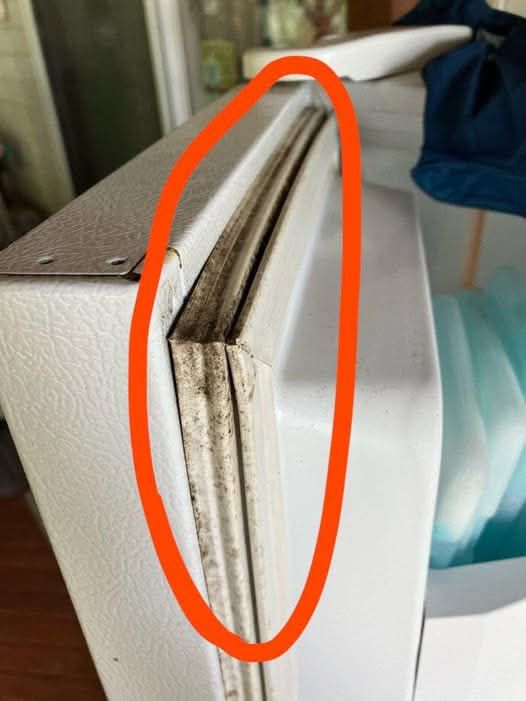ADVERTISEMENT
Instructions:
1. Empty the Fridge:
Before you begin, remove all food and items from your fridge. You don’t want any cleaning products coming in contact with your food, and it’s also easier to clean if the fridge is empty. Place food in a cooler to keep it safe while you clean. You can also use this opportunity to check for any expired items that need to be discarded.
2. Unplug the Fridge (Optional but Recommended):
While not strictly necessary, unplugging the fridge before cleaning is a good safety measure. This can prevent any accidental spills on electrical components and allow you to focus entirely on cleaning without the fridge running.
3. Clean the Interior of the Fridge Door:
To begin cleaning the fridge door, use a mixture of warm water and dish soap. Dampen a cloth or sponge with the soapy water and wipe down the door, removing any grime, food residue, or other debris. This will ensure that you’re cleaning a clean surface before tackling the mold.
4. Tackle the Mold:
Now, focus on the mold itself. There are a couple of natural cleaning agents that work wonders for mold removal:
- White Vinegar: White vinegar is a powerful natural cleaner with antifungal properties that kill mold and mildew. Pour some undiluted white vinegar into a spray bottle and spray it directly onto the moldy areas of the fridge door and the gasket. Let it sit for about 10-15 minutes to allow the vinegar to break down the mold.
- Hydrogen Peroxide: If the mold is particularly stubborn, hydrogen peroxide (3% solution) can also be used. Spray it generously onto the moldy spots and let it sit for about 10-15 minutes. Hydrogen peroxide works similarly to vinegar, but it’s often stronger and may be better for heavier mold buildup.
5. Scrub the Moldy Areas:
After allowing the vinegar or hydrogen peroxide to sit, use a soft sponge or a scrub brush to gently scrub away the mold. For smaller or tight spots like the rubber gasket, use an old toothbrush to scrub around the edges where the mold tends to accumulate. Be thorough but gentle to avoid damaging the surfaces.
If the mold is particularly stubborn, you can sprinkle some baking soda directly onto the scrub brush or sponge. The baking soda will act as an abrasive, helping to lift the mold while also deodorizing the area.
6. Rinse and Wipe Down:
Once the mold is gone, use a clean damp cloth or sponge to wipe away any cleaning solution and loosened mold residue. Make sure you remove all cleaning agents from the surface to avoid any lingering smells or residue.
7. Dry the Area Thoroughly:
Use a paper towel or a clean, dry cloth to thoroughly dry the fridge door and gasket. Mold thrives in damp environments, so it’s essential to ensure the surfaces are completely dry before closing the fridge door.
8. Clean the Gasket:
The fridge door gasket (the rubber seal around the edge) can often accumulate mold and grime. Apply the same cleaning methods (vinegar or hydrogen peroxide) to the gasket. Use an old toothbrush or soft cloth to scrub the gasket, making sure to get into all the crevices. If there is any mold left behind, you can repeat the cleaning process until it’s fully removed.
9. Reassemble and Check Regularly:
After you’ve cleaned and dried everything, replace the items in your fridge. As a preventive measure, check your fridge door and gasket regularly for signs of mold buildup. Wipe down the door weekly to ensure that mold doesn’t have a chance to return. Keep the fridge at the correct temperature (usually around 37°F or 3°C) to help prevent excessive moisture and mold growth.
Preventing Mold in the Future
Once you’ve cleaned the mold, it’s essential to take steps to prevent it from coming back. Here are a few tips to keep your fridge mold-free:
- Keep the Fridge Dry: Excess moisture is one of the main causes of mold. Wipe down any spills immediately, and ensure that food packaging is dry before storing it in the fridge.
- Check the Door Seal: Make sure the door gasket seals tightly. If the gasket is damaged or cracked, it could be letting in moisture and air, leading to mold growth. If necessary, replace the gasket to ensure a good seal.
- Regular Cleaning: Make it a habit to clean your fridge regularly—at least once a month. Regularly wipe down the fridge door and check for any signs of mold or moisture.
- Use Baking Soda: Place an open box of baking soda inside your fridge to absorb odors and moisture, helping to keep the environment dry and mold-free.
- Avoid Overloading the Fridge: Overcrowding your fridge can block airflow, which can lead to condensation and excess moisture, providing the perfect environment for mold. Make sure your fridge is organized and not overstuffed.
Conclusion
Cleaning mold from the fridge door might seem like a chore, but it’s a task that is entirely manageable with the right tools and techniques. By using natural cleaners like white vinegar or hydrogen peroxide, scrubbing with a soft brush, and keeping your fridge dry, you can eliminate mold and keep it from coming back.
Regular maintenance and cleaning will help your fridge stay fresh, hygienic, and mold-free, ensuring that you can continue to store your food safely without worrying about unwanted contaminants.
